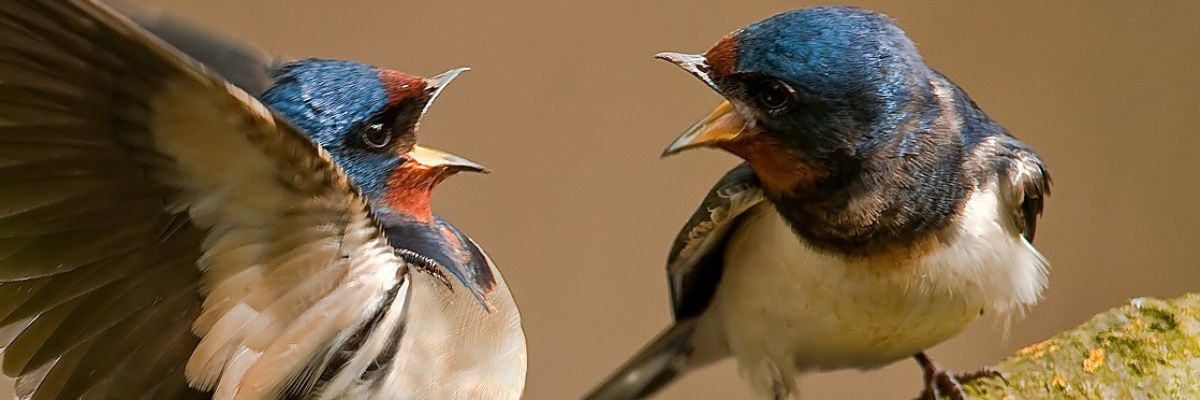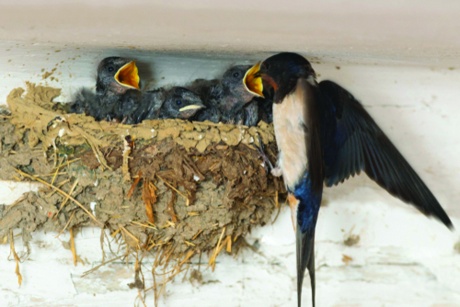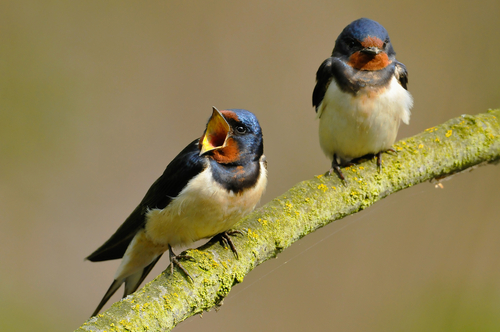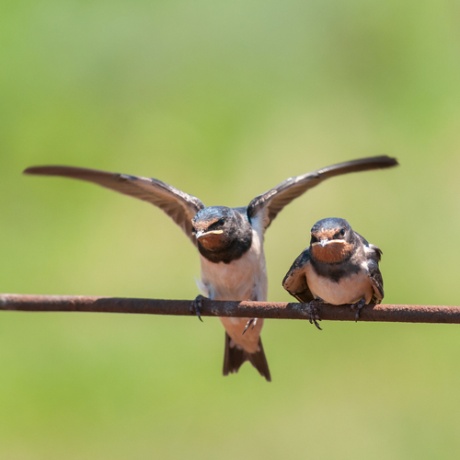
The extraordinary life of swallows. What do we know about them?
19. 10. 2022
Why do swallows like to keep their nests in order? And why are some females “unfaithful” and others not? What makes male swallows attractive? Researchers at the Institute of Vertebrate Biology of the CAS have been monitoring the lives of swallows for a long time. They have a unique database at their disposal which includes feather specimens from more than 6,000 birds. The story was first published in the Czech issue of the A / Věda a výzkum CAS magazine.
A male swallow flies to an unprotected nest and loiters at its edge for a moment, looking around before using its beak to fling the resident eggs out of the nest. In the neighbouring nest, there’s more drama: after about five attempts, a male swallow manages to chuck the chick out of the nest with the parents absent. It does not survive the fall to the ground. The swallow has already killed several of their offspring this way. Apparently, it wants to occupy the nest and start a family of its own. Ornithologists from the Institute of Vertebrate Biology of the CAS, who have been monitoring the barn swallow (Hirundo rustica) in the Třeboňsko Protected Landscape Area for thirteen years, have managed to capture the bird’s harsh practices it uses to fight for its place in the world.
Swallows are socially monogamous – males and females form temporary pairs that build nests together and care for their young. Although the pairs are stable during nesting, extra-pair copulation with birds in the vicinity is common. “Older, middle-aged males, who are three to four years old, are most successful in attracting extra-pair mates, and this is despite the fact that they have inferior sperm, according to our measurements. For females, their experience and perhaps some qualities related to having lived to such a blessed age are more important,” explains Tomáš Albrecht, the leader of the Avian Evolutionary Ecology Group at the Institute of Vertebrate Biology of the CAS.
Up to one-fifth of the chicks that hatch in the nests are from extra-pair copulations, fathered by a swallow other than the mother’s partner. Many swallow pairs manage to nest twice or exceptionally up to three times during the summer. On average, female swallows have between five to ten chicks per season. Male swallows are much more variable regarding the number of chicks they produce – in some nests, none of the chicks belong to those feeding them. Such fathers often have no young of their own in a season, but there are those, in contrast, who manage twenty-five.

Swallows regularly feed and care for the offspring of others.
Male swallows keep a close eye on their promiscuous mates; around 20 percent of male swallows, mostly young, one-year-old individuals, who have failed to find a social partner to mate with, approach them. On the other hand, female swallows always mate. There is an overabundance of males in the swallow population and not all of them can thus acquire a mate. In addition, females sometimes lay their eggs in the nests of others, leaving the incubation and care of the offspring to the step-parents. This is known as brood parasitism.
Big Brother
Caring for the eggs or chicks of others costs swallows energy, which has a negative impact on their own reproduction. The female swallow incubates the eggs for fourteen days and then both parents must feed the hatched offspring for approximately three weeks before it flies off on its own. To find out whether, due to brood parasitism, the birds have learned to recognise and discard the parasite egg, or whether it is “just” a habit of cleaning the nest – swallows are very tidy – the Czech researchers conducted an interesting experiment. They placed objects in their nests of colours and shapes different from swallows’ eggs. The researchers observed if the birds would take the colour or shape into account when throwing them out. If the swallows chose the colour as a factor, it would indicate that this was a purposefully developed defence against brood parasitism, as the parasite eggs differ from their own primarily in colour.
“The swallows, however, were guided by the shape of the objects alone and not their coloration. Objects that were egg-shaped were more readily accepted by the swallows than those in the shape of a star. This suggests that the ejection of parasite eggs is merely a manifestation of their highly developed sense of order in the nest,” Michal Šulc explains. For the third year now, he and his colleague Václav Jelínek from the Institute of Vertebrate Biology of the CAS have been filming the nests of swallows with special chip readers implanted under their skin. Researchers monitor up to sixty nests twenty-four hours a day. They can identify brood parasites and the killers of the chicks mentioned in the introduction of the article.
Ornithologists from the Czech Academy of Sciences, led by Tomáš Albrecht, have been collecting data on swallows for thirteen years in four locations – including an organic farm owned by an amateur ornithologist, a barn, and a stable where up to dozens of pairs can nest in a relatively small space. The ornithologists have put together a unique database with data on eleven thousand birds, which for the research of birds living in the wild is unparalleled. The swallow, with its diminutive size and long, deeply curved tail, remains faithful to the place where it first nested, allowing experts to systematically monitor and study the bird during its entire lifespan. These too are completely unique circumstances.
The researchers collect the necessary data during spring and summer, and four times a year they try to capture all the swallows in the monitored sites. This year, they managed to trap one hundred and seventy swallows in the prepared nets around the buildings where they were nesting. They tagged each swallow with a unique combination of coloured rings used to identify the individual birds. In a mobile laboratory located at the trapping site, the ornithologists then measured the birds’ condition, weight, and various morphometric and other traits that could (or theoretically should) serve as signals of sexual selection. They also take sperm samples, determine their mobility, and analyse the heritability of various traits.
Birds are de facto living dinosaurs, their own lineage going back to the Jurassic period one hundred and forty million years ago – some eighty million years after the first mammals. Birds (and dinosaurs in general) evolved in a reptilian lineage of quadrupeds, their last shared ancestor with mammals dating back to three hundred million years ago in the Carboniferous period. The two lineages then diverged – as mammals, we don’t have much in common with them. Their physical features and characteristics related to an active lifestyle developed simultaneously. Independently, they achieved warm-bloodedness. “They give us a glimpse of the parallel evolution of different traits and adaptations. From a mammalian point of view, they are a bit like aliens, as are we in turn for them,” Albrecht adds.

Michal Šulc and Tomáš Albrecht from the Institute of Vertebrate Biology of the CAS. (CC)
Two birds, one stone
What makes swallows attractive and how do they choose their mates? Researchers focused on one possible and often-discussed sexual trait in swallows: the elongated tail feathers in males and the shape and extent of the deeply forked tail streamers. Their results suggest that one day, bio textbooks may need to be rewritten. “Although you will find in every textbook that tail feathers are a strong sexual trait based on which females choose both mated and unmated partners, our data does not support this,” Albrecht explains.
However, tail feathers may play a role as a sign of dominance when males are trying to dislodge a competitor from an already occupied nest. In the spring, those males that arrive first from warm-climate Africa, often alone, hold the advantage. The firstcomers can occupy the vacant nests from previous years. After finding a mate, the swallows just clean up the nest and refurbish it. It takes a pair of swallows one week to build an entire nest out of mud – and they work hard, all day long. Some swallows, in an attempt to avoid such a hassle, prefer trying to drive other birds out of already occupied nests or killing the residing chicks.
Swallows (especially males) remain loyal to the place where they first nested. This allows researchers to use their rich database and DNA to reconstruct the birds’ lifespan and complex familial relationships. As many as 30 nests can appear in a single location and infidelity is widespread. “We know how long each bird lived, how successful it was during its lifetime, whether it managed to find a mate, and how many young it was able to produce in its lifetime,” Albrecht explains.
During capture, ornithologists also take blood samples from the swallows to identify parasites and for haematological screening, which, among other things, indicates the condition of the individual. They also focus on malaria, which is usually contracted by swallows at their winter roost sites and can be fatal for them. It is not known how many swallows succumb to the disease in Africa, where they experience the acute phase of it. One-quarter of the birds arrive here in the chronic phase of malaria. “We want to link malaria to the aging process and how it is affected by parasites and pathogens. The disease can cause a swallow to have a biological age that does not correspond to their chronological age," Albrecht explains. The results of the research could help not only in veterinary practice, but also in medicine, providing a general understanding of the long-term or lifelong impact of chronic malaria on the condition of infected swallows.

The oldest swallow recorded by the Czech ornithologists was eight years old – but most live for one to two years on average.
Let’s accommodate swallows
The harbingers of spring like to build their nests in the interiors of farm buildings, enjoying the warmth that the livestock generates. If the animals disappear from a given location, the swallows disappear within a few years as well, the chicks refusing to settle there. After hatching, young swallows scout out possible future nesting sites, choosing carefully where to settle permanently. At this stage, the chicks are apparently able to fly several tens of kilometres. If they take a liking to a place, they keep returning to it throughout their lives. This season, ornithologists had to rent out six sheep for one of the nesting sites for the summer in order to make the environment suitable for the new swallows. That’s because the farmer in whose barn they had been monitoring the birds for years had decided to stop with sheep farming.
Despite the feeling that there are plenty of swallows all around us, according to Tomáš Albrecht, swallows are mostly an endangered species. There are fewer and fewer places for them to nest and modern agriculture is, in comparison to traditional agriculture, almost unhealthily sterile. “People don’t keep chickens or pigs traditionally like they used to, even in the countryside. Barns and cowsheds, for instance, are often so clean you could eat off the floor, and owners of largescale farms often get rid of swallows’ nests for the sake of keeping things clean and tidy.”
Swallows always disappear in late August and early September, abandoning their nests in the barns and sheds. Most of them actually relocate to roost in the reeds before flying off to Africa and disappearing altogether. This behaviour has confused people in the past. They thought the birds buried themselves in mud for winter hibernation and re-emerged in the spring. “People really believed that. A case in point – there is a Swedish painting from the 17th century that depicts swallows being caught with a fishing net,” Albrecht recalls.
Before the long journey to their winter roost sites, swallow pairs break up and each fly off on their own in search of a warmer climate. They are probably never to be reunited again. “We know of some cases where two swallows have mated together for two years in a row, but it’s a matter of chance and not common,” Albrecht adds.
Wherefore art thou, swallow?
Swallows from southern Bohemia winter in the tropical rainforests of the Congo and in the savannahs of southern Africa. They are skilled and efficient fliers, capable of covering long distances and difficult terrain. They can make the journey in several weeks. We do not have much information about what happens in the air on the way, where exactly they stop, and why.
Satellite radios, which are used successfully in monitoring large bird species and could provide answers, are too heavy to be carried by swallows. The birds can at least be equipped with a tiny geolocator. Even that though is at the very limit of the maximum recommended weight that these birds, weighing a mere seventeen to twenty grams, can carry. The geolocator automatically records time and light data, i.e., sunsets and sunrises. Once the bird is recaptured the following year and the data is downloaded, researchers are able to use the data to calculate approximately where the swallow flew south and where it spent the winter.

The chances of the swallow surviving to the next year are around 50%. Most of the time, they are captured by predators on their way to warmer regions.
It is possible to roughly localise the habitat in which the swallow winters by analysing the carbon and nitrogen isotopes present in the bird’s feathers. This is exchanged by the birds at their wintering roost sites. Different habitats (e.g., the savanna and the forest) are characterised by specific plants and, consequently, specific carbon and nitrogen isotope ratios. Swallows store these elements in their growing feathers from the food they intake, insects, which in turn live off the plants in the specific habitats. Their feathers preserve the carbon and nitrogen isotopes and can be used for analyses.
Sex and stress hormones are also stored in the growing feathers. Their analysis reveals what condition the birds were in on their wintering roost sites. “What’s interesting is that swallow feathers form stripes as they grow, like the growth rings of trees. One per day. We can thus tell how fast it grew by the width of the stripes,” Albrecht explains. Since 2010, his research team has been putting together a unique collection of barn swallow feathers.
Despite their popularity, swallows are still relatively under-researched, and many questions remain unanswered. Thanks to the unique dataset at their disposal, however, researchers can gradually piece together a complex mosaic of the bird and continue to ask: how does the swallow age? Is promiscuity a useful strategy? Do female swallows also benefit from it? What control does the female have over fertilisation? Are chicks raised by stepparents at any disadvantage? Answers to these questions might one day help those of us who have followed a different path in the evolutionary lineage to better understand our own reproductive systems and behaviour. After all, we can ask similar questions regarding our society: why do most human cultures promote monogamy? Is it a convenient strategy for us, or is it because we like to keep things in order – like in the case of swallows?
The text is taken from the Czech-language A / Věda a výzkum magazine, published by the Czech Academy of Sciences. The issue (in Czech) can be read below:
Written by: Zuzana Šprinclová, Division of External Relations, CAO of the CAS
Translated by: Tereza Novická, Division of External Relations, CAO of the CAS
Photo: Shutterstock, Jana Plavec, Division of External Relations, CAO of the CAS
 The text and photos marked CC are released for use under the Creative Commons license.
The text and photos marked CC are released for use under the Creative Commons license.
Read also
- SUNER-C concludes after three years dedicated to the renewable energy future
- A trapped state: The pandemic impact on public attitudes, trust, and behavior
- Aerial archaeology: Tracing the footsteps of our ancestors from the sky
- Archaeologists uncover ancient finds along Prague Ring Road
- Our microbiome largely depends on what we eat, says microbiologist Michal Kraus
- The ABCs of writing: Why did its invention mark a turning point for humankind?
- We learn, remember, forget… What can memory actually do? And can we outsmart it?
- New Center for Electron Microscopy in Brno opens its doors to global science
- The hidden lives of waste: What can we learn from waste workers and pickers?
- A unique lab is hidden right beneath Prague’s Vítkov Hill
The Czech Academy of Sciences (the CAS)
The mission of the CAS
The primary mission of the CAS is to conduct research in a broad spectrum of natural, technical and social sciences as well as humanities. This research aims to advance progress of scientific knowledge at the international level, considering, however, the specific needs of the Czech society and the national culture.
President of the CAS
Prof. Eva Zažímalová has started her second term of office in May 2021. She is a respected scientist, and a Professor of Plant Anatomy and Physiology.
She is also a part of GCSA of the EU.
